door lock HONDA ELEMENT 2003 1.G Owners Manual
[x] Cancel search | Manufacturer: HONDA, Model Year: 2003, Model line: ELEMENT, Model: HONDA ELEMENT 2003 1.GPages: 338, PDF Size: 4.08 MB
Page 6 of 338
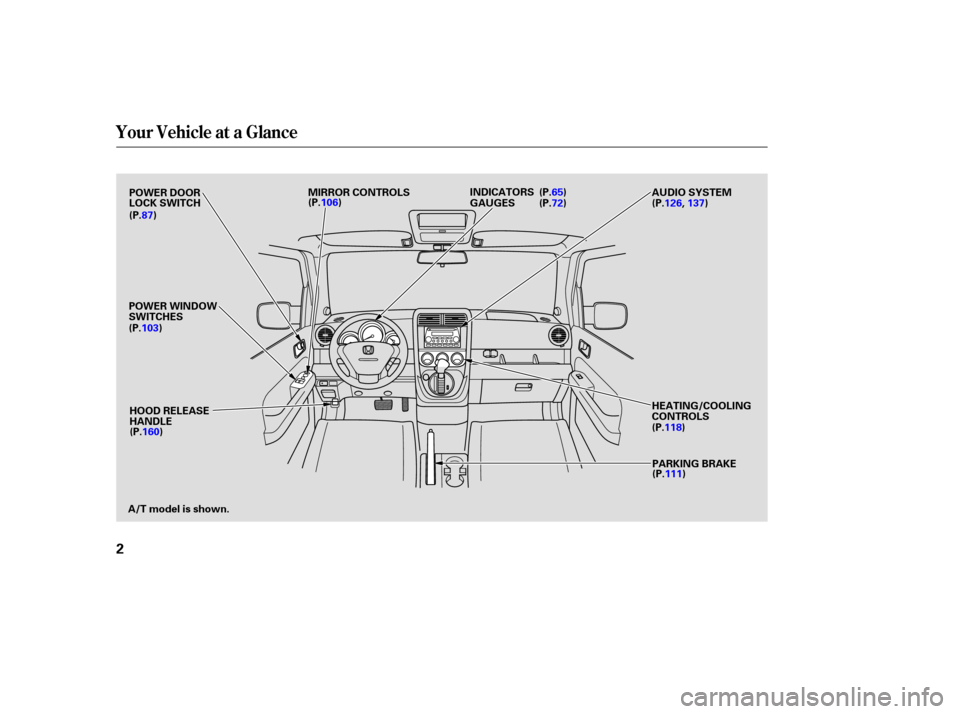
Your Vehicle at a Glance
2
POWER DOOR
LOCK SWITCHMIRROR CONTROLS
GAUGES INDICATORS (P.65)
(P.72) AUDIO SYSTEM
HEATING/COOLING
CONTROLS PARKING BRAKE
POWER WINDOW
SWITCHES
A/T model is shown. HOOD RELEASE
HANDLE
(P.87)
(P.103) (P.160) (P.106)
(P.126,137)
(P.118) (P.111)
Page 9 of 338
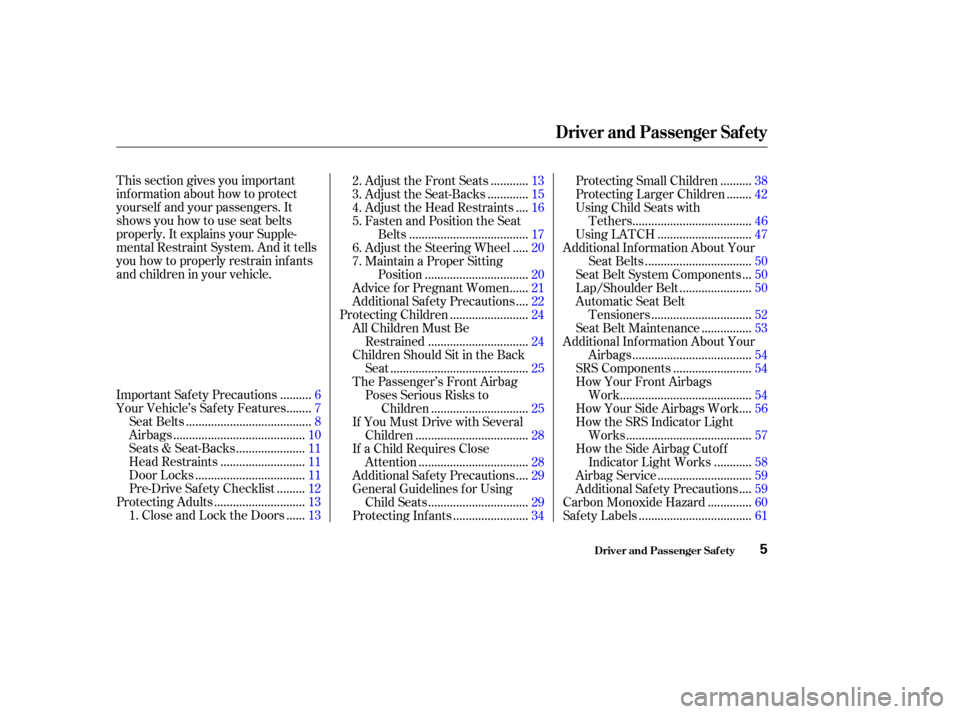
This section gives you important
inf ormation about how to protect
yourself and your passengers. It
shows you how to use seat belts
properly. It explains your Supple-
mental Restraint System. And it tells
you how to properly restrain inf ants
and children in your vehicle..........
Important Safety Precautions . 6
.......
Your Vehicle’s Saf ety Features . 7
.......................................
Seat Belts .8
.........................................
Airbags .10
.....................
Seats & Seat-Backs .11
..........................
Head Restraints .11
..................................
Door Locks .11
........
Pre-Drive Saf ety Checklist . 12
............................
Protecting Adults .13
.....
1. Close and Lock the Doors . 13 ...........
2. Adjust the Front Seats . 13
............
3. Adjust the Seat-Backs . 15
...
4. Adjust the Head Restraints . 16
5. Fasten and Position the Seat .....................................
Belts .17
....
6. Adjust the Steering Wheel . 20
7. Maintain a Proper Sitting ................................
Position .20
.....
Advice f or Pregnant Women . 21
...
Additional Safety Precautions . 22
........................
Protecting Children .24
All Children Must Be ...............................
Restrained .24
Children Should Sit in the Back ...........................................
Seat .25
The Passenger’s Front Airbag Poses Serious Risks to ..............................
Children .25
If You Must Drive with Several ...................................
Children .28
If a Child Requires Close ..................................
Attention .28
...
Additional Safety Precautions . 29
General Guidelines f or Using ...............................
Child Seats .29
.......................
Protecting Inf ants .34 .........
Protecting Small Children . 38
.......
Protecting Larger Children . 42
Using Child Seats with .....................................
Tethers .46
.............................
Using LATCH .47
Additional Inf ormation About Your .................................
Seat Belts .50
..
Seat Belt System Components . 50
......................
Lap/Shoulder Belt .50
Automatic Seat Belt ...............................
Tensioners .52
...............
Seat Belt Maintenance . 53
Additional Inf ormation About Your .....................................
Airbags .54
........................
SRS Components .54
How Your Front Airbags .........................................
Work .54
...
How Your Side Airbags Work . 56
How the SRS Indicator Light .......................................
Works .57
How the Side Airbag Cutof f ...........
Indicator Light Works . 58
.............................
Airbag Service .59
...
Additional Safety Precautions . 59
.............
Carbon Monoxide Hazard . 60
...................................
Saf ety Labels .61
Driver and Passenger Saf ety
Driver and Passenger Saf ety5
Page 11 of 338
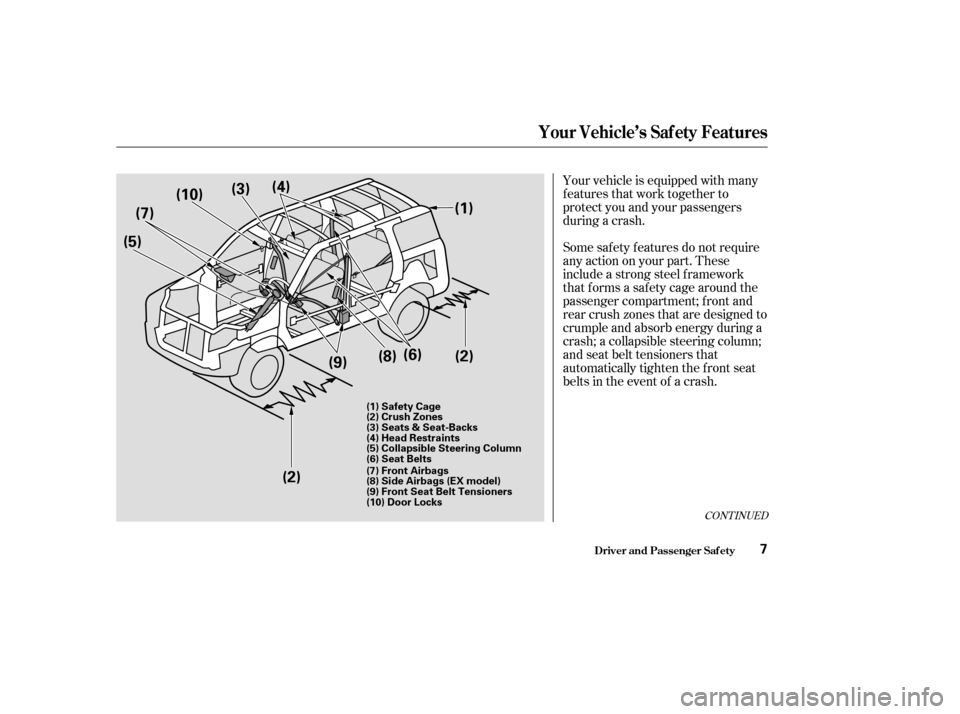
Your vehicle is equipped with many
features that work together to
protect you and your passengers
during a crash.
Some saf ety f eatures do not require
anyactiononyourpart.These
include a strong steel f ramework
that forms a safety cage around the
passenger compartment; f ront and
rear crush zones that are designed to
crumple and absorb energy during a
crash; a collapsible steering column;
and seat belt tensioners that
automatically tighten the front seat
belts in the event of a crash.
CONT INUED
Driver and Passenger Saf ety
Your Vehicle’s Saf ety Features
7
(1)(2)
(2)
(3)
(4)
(5)
(8)(6)
(9)
(7)
(10)
(1) Safety Cage
(2) Crush Zones
(3) Seats & Seat-Backs
(4) Head Restraints
(5) Collapsible Steering Column
(6) Seat Belts
(7) Front Airbags
(8) Side Airbags (EX model)
(9) Front Seat Belt Tensioners
(10) Door Locks
Page 15 of 338

Your vehicle’s seats are designed to
keep you in a comf ortable, upright
position so you can take f ull
advantage of the protection offered
by seat belts and the energy
absorbing materials in the seats.Head restraints can help protect you
f rom whiplash and other injuries. For
maximum protection, the back of
your head should rest against the
center of the head restraint.
Reclining a seat-back too f ar reduces
the seat belt’s ef f ectiveness and
increases the chance that the seat’s
occupant will slide under the seat
belt in a crash and be seriously
injured. Move the f ront
seats as far back as possible, and
keep adjustable seat-backs in an
upright position whenever the
vehicle is moving. Keeping your doors locked reduces
thechanceof beingthrownoutof
the vehicle during a crash. It also
helps prevent occupants f rom
accidentally opening a door and
f alling out, and outsiders f rom
unexpectedly opening your doors.
How you adjust your seats and seat-
backs can also affect your safety. For
example, sitting too close to the
steering wheel or dashboard
increases the risk of you or your
passenger being injured by striking
theinsideof thevehicle,orbyan
inf lating airbag. Seats & Seat-Backs
Head RestraintsDoor L ocks
What you should do:
Your Vehicle’s Saf ety Features
Driver and Passenger Saf ety11
Page 16 of 338
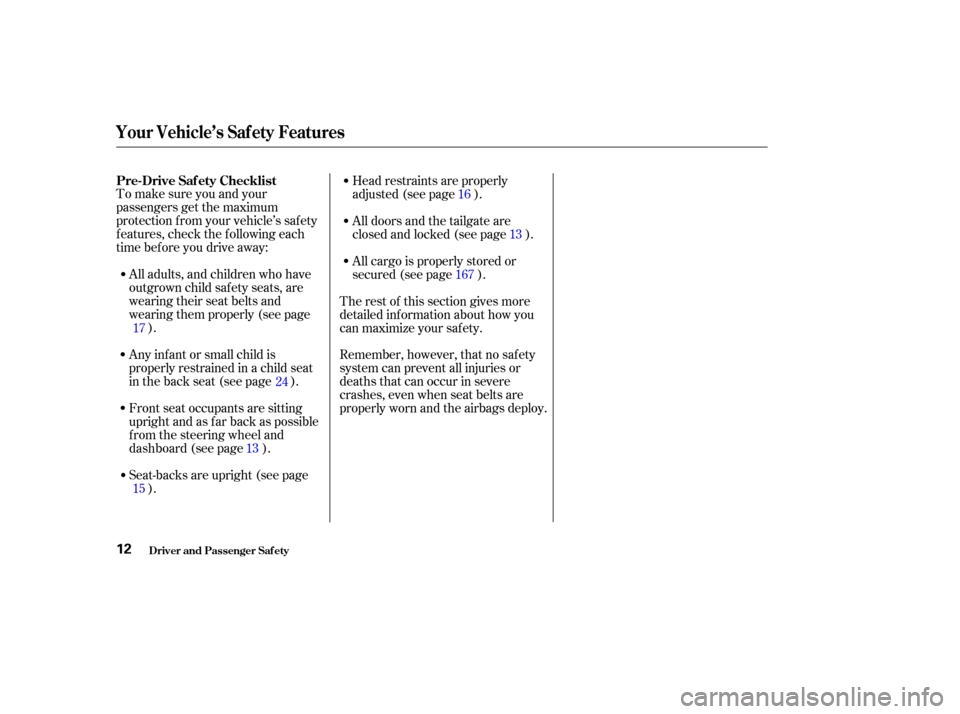
To make sure you and your
passengers get the maximum
protection f rom your vehicle’s saf ety
f eatures, check the f ollowing each
time before you drive away:All adults, and children who have
outgrown child saf ety seats, are
wearing their seat belts and
wearingthemproperly(seepage ).
Any inf ant or small child is
properly restrained in a child seat
inthebackseat(seepage ).
Frontseatoccupantsaresitting
upright and as f ar back as possible
f rom the steering wheel and
dashboard (see page ).
Seat-backs are upright (see page ). Head restraints are properly
adjusted (see page ).
Alldoorsandthetailgateare
closed and locked (see page ).
All cargo is properly stored or
secured (see page ).
The rest of this section gives more
detailed inf ormation about how you
can maximize your saf ety.
Remember, however, that no saf ety
system can prevent all injuries or
deaths that can occur in severe
crashes, even when seat belts are
properly worn and the airbags deploy.
17
24
13
15 16
13
167
Pre-Drive Saf ety Checklist
Your Vehicle’s Saf ety Features
Driver and Passenger Saf ety12
Page 17 of 338
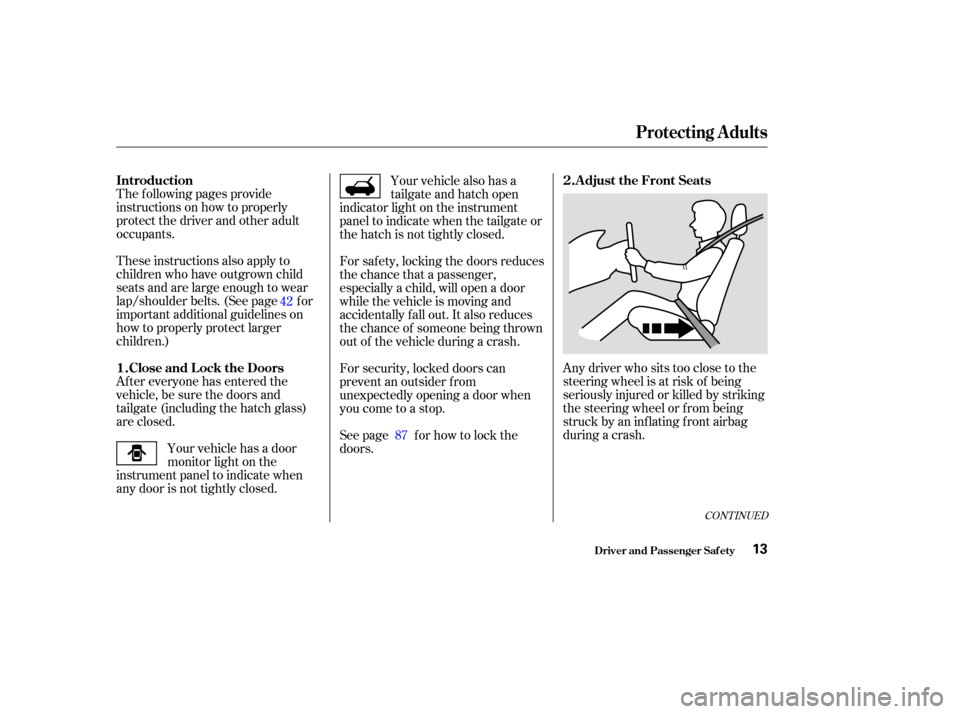
The f ollowing pages provide
instructions on how to properly
protect the driver and other adult
occupants.
These instructions also apply to
children who have outgrown child
seats and are large enough to wear
lap/shoulder belts. (See page f or
important additional guidelines on
how to properly protect larger
children.)
Af ter everyone has entered the
vehicle, be sure the doors and
tailgate (including the hatch glass)
are closed.Your vehicle has a door
monitor light on the
instrument panel to indicate when
any door is not tightly closed. Any driver who sits too close to the
steering wheel is at risk of being
seriously injured or killed by striking
the steering wheel or f rom being
struck by an inflating front airbag
during a crash.
Your vehicle also has a
tailgate and hatch open
indicator light on the instrument
panel to indicate when the tailgate or
the hatch is not tightly closed.
For saf ety, locking the doors reduces
the chance that a passenger,
especially a child, will open a door
while the vehicle is moving and
accidentally f all out. It also reduces
the chance of someone being thrown
out of the vehicle during a crash.
For security, locked doors can
prevent an outsider f rom
unexpectedly opening a door when
you come to a stop.
See page f or how to lock the
doors.
42
87
CONT INUED
Introduction
Close and L ock the Doors Adjust the Front Seats
1. 2.
Protecting Adults
Driver and Passenger Saf ety13
Page 33 of 338

CONT INUED
The f ollowing pages give general
guidelines f or selecting and installing
child seats f or inf ants and small
children.
Even very young
children learn how to unlock
vehicle doors, turn on the ignition,
and open the tailgate or hatch,
which can lead to accidental injury
or death. Children
who play in vehicles can
accidentally get trapped inside the
vehicle. Teach your children not to
play in or around vehicles.
Leaving children without
adult supervision is illegal in most
states and Canadian provinces,
and can be very hazardous. For
example, inf ants and small
childrenleftinavehicleonahot
day can die f rom heatstroke. And
children lef t alone with the key in
the ignition can accidentally set
the vehicle in motion, possibly
injuring themselves or others.
Driver and Passenger Saf ety
Protecting Children
General Guidelines f or Using
Child Seats
Additional Saf ety Precautions
K eep vehicle keys out of t he reach
of children.
L ock all doors and t he hat ch when
your vehicle is not in use.
Do not leave children alone in your
vehicle.
29
Page 54 of 338
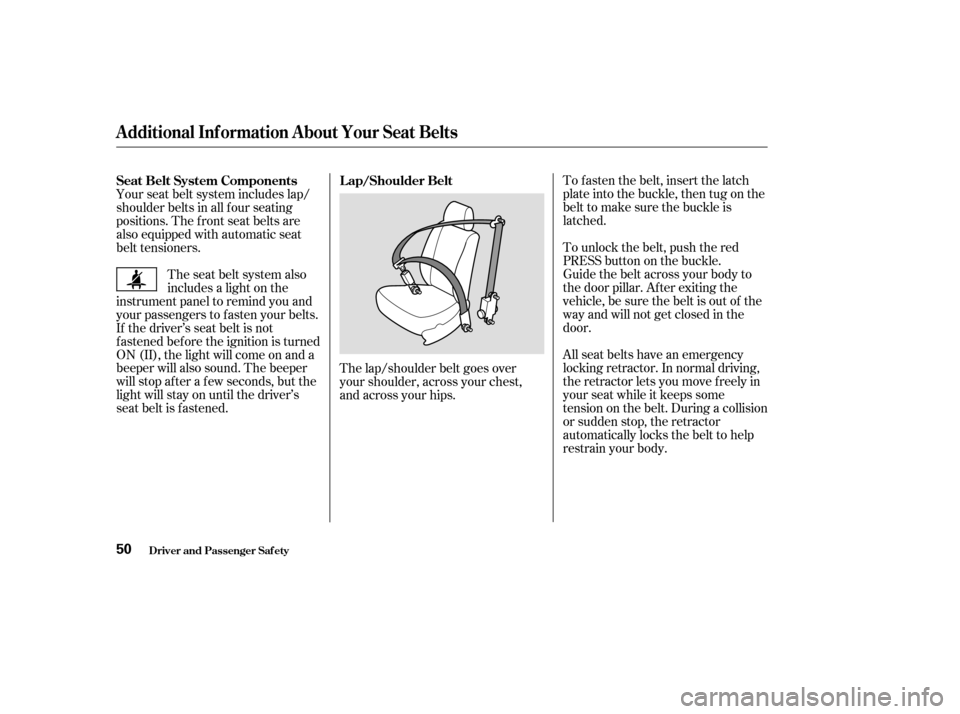
To fasten the belt, insert the latch
plate into the buckle, then tug on the
belt to make sure the buckle is
latched.
To unlock the belt, push the red
PRESSbuttononthebuckle.
Guide the belt across your body to
the door pillar. Af ter exiting the
vehicle, be sure the belt is out of the
way and will not get closed in the
door.
All seat belts have an emergency
locking retractor. In normal driving,
the retractor lets you move f reely in
your seat while it keeps some
tension on the belt. During a collision
or sudden stop, the retractor
automatically locks the belt to help
restrain your body.
The seat belt system also
includes a light on the
instrument panel to remind you and
your passengers to f asten your belts.
If the driver’s seat belt is not
fastened before the ignition is turned
ON (II), the light will come on and a
beeper will also sound. The beeper
will stop af ter a f ew seconds, but the
light will stay on until the driver’s
seat belt is f astened. The lap/shoulder belt goes over
your shoulder, across your chest,
and across your hips.
Your seat belt system includes lap/
shoulder belts in all f our seating
positions. The f ront seat belts are
also equipped with automatic seat
belt tensioners. Seat Belt System Components L ap/Shoulder Belt
Additional Inf ormation About Your Seat Belts
Driver and Passenger Saf ety50
Page 67 of 338
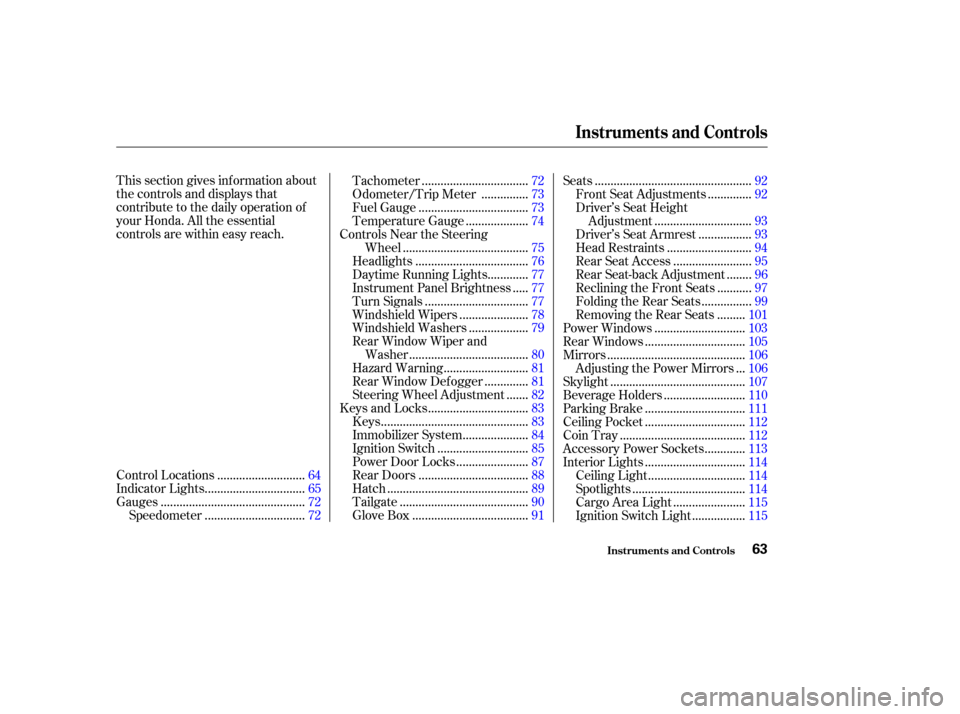
This section gives inf ormation about
the controls and displays that
contribute to the daily operation of
your Honda. All the essential
controls are within easy reach............................
Control Locations .64
...............................
Indicator Lights .65
.............................................
Gauges .72
...............................
Speedometer .72 .................................
Tachometer .72
..............
Odometer/Trip Meter . 73
..................................
Fuel Gauge .73
...................
Temperature Gauge . 74
Controls Near the Steering .......................................
Wheel .75
...................................
Headlights .76
............
Daytime Running Lights . 77
....
Instrument Panel Brightness . 77
................................
Turn Signals .77
.....................
Windshield Wipers .78
..................
Windshield Washers . 79
Rear Window Wiper and .....................................
Washer .80
..........................
Hazard Warning .81
.............
Rear Window Def ogger . 81
......
Steering Wheel Adjustment . 82
...............................
Keys and Locks .83
..............................................
Keys .83
....................
Immobilizer System . 84
............................
Ignition Switch .85
......................
Power Door Locks .87
..................................
Rear Doors .88
............................................
Hatch .89
........................................
Tailgate .90
....................................
Glove Box .91 .................................................
Seats .92
.............
Front Seat Adjustments . 92
Driver’s Seat Height ..............................
Adjustment .93
................
Driver’s Seat Armrest . 93
..........................
Head Restraints .94
........................
Rear Seat Access .95
.......
Rear Seat-back Adjustment . 96
..........
Reclining the Front Seats . 97
...............
Folding the Rear Seats . 99
........
Removing the Rear Seats . 101
............................
Power Windows .103
...............................
Rear Windows .105
...........................................
Mirrors .106
..
Adjusting the Power Mirrors . 106
..........................................
Skylight .107
.........................
Beverage Holders .110
...............................
Parking Brake .111
...............................
Ceiling Pocket .112
.......................................
Coin Tray .112
............
Accessory Power Sockets . 113
...............................
Interior Lights .114
..............................
Ceiling Light .114
...................................
Spotlights .114
......................
Cargo Area Light .115
................
Ignition Switch Light . 115
Instruments and Controls
Inst rument s and Cont rols63
Page 68 of 338
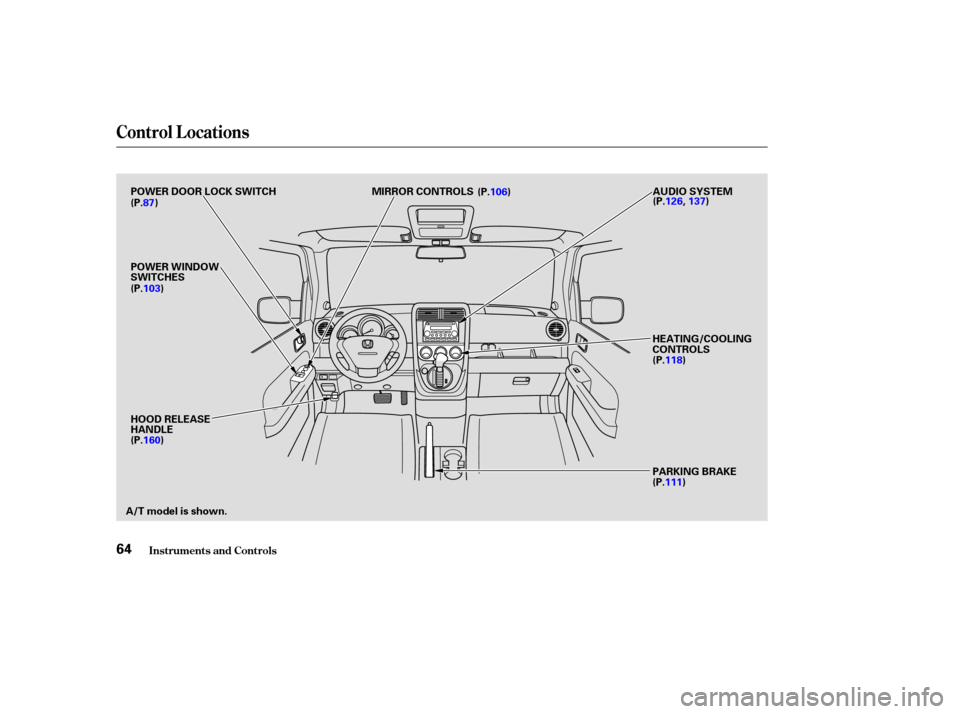
Control L ocations
Inst rument s and Cont rols64
POWER DOOR LOCK SWITCHMIRROR CONTROLS AUDIO SYSTEM
PARKING BRAKE
A/T model is shown. HOOD RELEASE
HANDLE POWER WINDOW
SWITCHES
HEATING/COOLING
CONTROLS
(P.87)
(P.103)
(P.160)
(P.118)(P.126,
137)
(P.106)
(P.111)